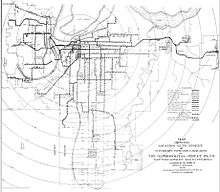Streetcars in Kansas City


During the late 19th and early 20th centuries, Kansas City, Missouri, like most North American cities, operated streetcars in Kansas City as their primary public transit mode.[2][3]
Kansas City once had one of the most extensive streetcar systems in North America, but the last of its 25 streetcar routes was shut down in 1957.[4] Indeed, all but five North American cities – Toronto, Boston, Philadelphia, San Francisco and New Orleans – replaced all their streetcar networks with buses, including Kansas City; three other cities, Newark, Pittsburgh, and Cleveland, operated rail lines more akin to modern light rail that are still in operation to this day.
History
Horsecar and cable car era
The first streetcars introduced in Kansas City in 1870 were horse-powered.[5]
On some early routes the streetcars were propelled by gripping moving underground cables, like San Francisco's cable cars.[1]
The city granted its first franchise to the Metropolitan Street Railway Company, owned by Thomas Corrigan.[6] William Rockhill Nelson, publisher of the Kansas City Star, believed Corrigan was corrupt, and used his paper to lobby against renewing his franchise.
Electrified streetcars
By 1908, all but one of the city's streetcar routes had been converted to being powered by electricity.[1]
When the Kansas City Public Service Company (KSPS) was created in 1925 it inherited over 700 streetcars that had been owned and operated by private companies.[5] The streetcar routes operated by the KSPS also served commuters across the state line in Kansas City, Kansas.[4]
The KSPS planned to replace all its older streetcars with new, state-of-the-art PCC streetcars, an order that would have required 371 vehicles. Only 24 were delivered prior to World War II, which put a hiatus on new streetcar construction. The KSPS ultimately acquired 184 PCC vehicles.
Well-known Kansas City developer Jesse C. Nichols was known for constructing streetcar lines to serve the new communities he built.[7]
Modern streetcars
A modern streetcar was installed in 2014 and opened to the public in 2016 -- KC Streetcar. It runs a similar, but shorter, route to the last line that ran when service ended in 1957.
References
- 1 2 3 "Post Office". Kansas City Public Library. 1979-06-01. Archived from the original on 2013-12-25. Retrieved 2013-12-25.
Some of the lines were once horse car lines, some cable lines and some electric. All are electric in 1908 except a portion of the 12th Street lines, between Washington Street and the stockyards. (There) the cable line is used pending the construction of some kind of a trafficway between the higher and lower levels of the city.
- ↑ Lynn Horsley (2013-11-22). "Kansas City's streetcar glory days hold lessons for today". Kansas City Star. Archived from the original on 2013-12-24. Retrieved 2013-12-24.
As Kansas City lays its first streetcar rail in 66 years, it is unleashing a wave of nostalgia for the days when the city had one of the nation’s most extensive streetcar systems.
- ↑ Edward A. Conrad (2011). Kansas City Streetcars: From Hayburners to Streamliners. HeartlandRails Publishing Company. ISBN 9780976184720. Retrieved 2013-12-28.
When it came to rail-based mass transit, Kansas City had it all. From the first horse car to the last streetcar, the KC transit scene was replete with every type of public transit during its 88 years of existence.
- 1 2 "Historic streetcars in San Francisco: Kansas City, Missouri-Kansas". Market Street Railway. 2010. Archived from the original on 2010-04-12. Retrieved 2013-12-25.
Kansas City’s PCCs - 184 in all - were painted to emphasize their modern lines, with a black ‘swoosh’ on the sides to highlight the logo of Kansas City Public Service Company (KCPS), which featured Frederic Remington’s famed sculpture “The Scout” on a red heart.
- 1 2 Monroe Dodd (2002-01-01). "A Splendid Ride: The Streetcars of Kansas City, 1870-1957". Kansas City Star Books. ISBN 9780972273985. Retrieved 2013-12-25.
- ↑ Jason Roe. "Wrong way Corrigan". Kansas City Public Library. Archived from the original on 2013-12-25. Retrieved 2013-12-25.
On March 31, 1882, The Kansas City Star declared its opposition to the streetcar monopoly then held by Thomas Corrigan. Although William Rockhill Nelson, owner of The Star, generally preferred that the paper remain neutral in politics, he made exceptions for cases where he believed rampant corruption demanded public awareness.
- ↑ William S. Worley (1993). "J.C. Nichols and the shaping of Kansas City : innovation in planned residential communities". University of Missouri Press. ISBN 9780826209269. Retrieved 2013-12-24.
External links
 Media related to 20th Century streetcars in Kansas City, Missouri at Wikimedia Commons
Media related to 20th Century streetcars in Kansas City, Missouri at Wikimedia Commons